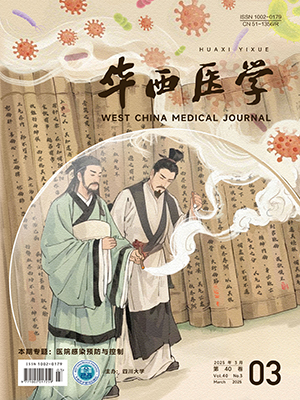| 1. |
Li Q, Guan X, Wu P, et al. Early transmission dynamics in Wuhan, China, of novel coronavirus-Infected pneumonia. N Engl J Med, 2020, 382(13): 1199-1207.
|
| 2. |
中华人民共和国国家卫生健康委员会. 新型冠状病毒肺炎诊疗方案 (试行第七版). (2020-03-03)[2020-03-04]. http://www.nhc.gov.cn/yzygj/s7653p/202003/46c9294a7dfe4cef80dc7f5912eb1989.shtml.
|
| 3. |
熊成龙, 蒋露芳, 姜庆五. β-冠状病毒引起人类疾病的流行与控制. 上海预防医学, 2020, 32(1): 57-65.
|
| 4. |
Huang C, Wang Y, Li X, et al. Clinical features of patients infected with 2019 novel coronavirus in Wuhan, China. Lancet, 2020, 395(10223): 497-506.
|
| 5. |
WHO. Clinical management of severe acute respiratory infection when Novel coronavirus (nCoV) infection is suspected: interim guidance. (2020-01-11)[2020-03-04]. https://www.who.int/internalpublications-detail/clinical-management-of-severe-acute-respiratoryinfection-when-novel-coronavirus-(ncov)-infection-is-suspected.
|
| 6. |
Shimabukuro-Vornhagen A, Gödel P, Subklewe M, et al. Cytokine release syndrome. J Immunother Cancer, 2018, 6(1): 56.
|
| 7. |
Chousterman BG, Swirski FK, Weber GF. Cytokine storm and sepsis disease pathogenesis. Semin Immunopathol, 2017, 39(5): 517-528.
|
| 8. |
Younan P, Iampietro M, Nishida AA, et al. Ebola virus binding to Tim-1 on T lymphocytes induces a cytokine storm. MBio, 2017, 8(5): e00845-17.
|
| 9. |
Ko JH, Park GE, Lee JY, et al. Predictive factors for pneumonia development and progression to respiratory failure in MERS-CoV infected patients. J Infect, 2016, 73(5): 468-475.
|
| 10. |
Liu CL, Lu YT, Peng MJ, et al. Clinical and laboratory features of severe acute respiratory syndrome vis-a-vis onset of fever. Chest, 2004, 126(2): 509-517.
|
| 11. |
Leem AY, Park B, Kim YS, et al. Incidence and risk of chronic obstructive pulmonary disease in a Korean community-based cohort. Int J Chron Obstruct Pulmon Dis, 2018, 5(13): 509-517.
|
| 12. |
Guo L, Wei D, Zhang X, et al. Clinical features predicting mortality risk in patients with viral pneumonia: the MuLBSTA score. Front Microbiol, 2019, 3(10): 2752.
|
| 13. |
La Gruta NL, Kedzierska K, Stambas J, et al. A question of self-preservation: immunopathology in influenza virus infection. Immunol Cell Biol, 2007, 85(2): 85-92.
|
| 14. |
Chung M, Bernheim A, Mei X, et al. CT imaging features of 2019 novel coronavirus (2019-nCoV). Radiology, 2020, 295(1): 202-207.
|
| 15. |
Koo HJ, Lim S, Choe J, et al. Radiographic and CT features of viral pneumonia. Radiographics, 2018, 38(3): 719-739.
|
| 16. |
Wang D, Hu B, Hu C, et al. Clinical characteristics of 138 hospitalized patients with 2019 novel coronavirus-infected pneumonia in Wuhan, China. JAMA, 2020, 323(11): 1061-1069.
|
| 17. |
华中科技大学同济医学院附属同济医院救治医疗专家组. 新型冠状病毒感染的肺炎诊疗快速指南 (第三版). (2020-01-28)[2020-03-04]. https://www.tjh.com.cn/html/2020/0128/28713.shtml.
|
| 18. |
白浪, 王铭, 唐小琼, 等. 对新型冠状病毒肺炎诊疗中的热点问题的思考. 华西医学, 2020, 35(2): 125-131.
|




